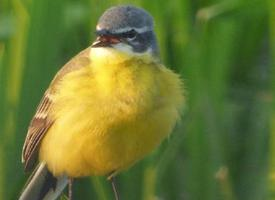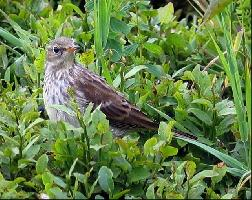
Poids et mesures
| Longueur | de 18 à 19 cm |
|---|---|
| Poids | de 15 à 21 g |
| Envergure des ailes | de 25 à 27 cm |
Statut de conservation
| Menacé |
Description de l'animal
The Grey Wagtail (Motacilla cinerea) is a small, slender bird that is a member of the wagtail family, Motacillidae. This species is particularly noted for its striking plumage and dynamic behavior. It is native to various regions across Europe and Asia, with some populations migrating to Africa during the winter. The Grey Wagtail is often found near bodies of water, such as rivers, streams, and lakes, where it hunts for insects and small invertebrates.One of the most distinctive features of the Grey Wagtail is its long, constantly wagging tail, from which it gets its name. The tail's movement is thought to startle insects, making them easier to catch. The bird's plumage is another notable characteristic. Males, especially during the breeding season, display a vivid lemon-yellow underbelly that contrasts sharply with their slate-grey upper parts. The females and juveniles are more subdued in color but still maintain the characteristic yellow underparts, though in a paler shade. Both sexes have a white supercilium (eyebrow) that stands out against their grey heads.
The Grey Wagtail measures about 18-20 cm in length, with a wingspan that ranges from 25 to 30 cm. Despite its small size, it is an agile flyer and an adept forager. It often feeds by walking along the ground or wading into shallow water, darting swiftly to snatch up prey with its sharp beak. Its diet mainly consists of insects such as beetles, flies, and larvae, but it can also eat small crustaceans and mollusks.
Breeding usually occurs from April to July. The Grey Wagtail builds its nest in a concealed location near water, often under a bridge, in a crevice, or among rocks. The nest is a neat cup-shaped structure made from grass, moss, and leaves, lined with softer materials like feathers. The female lays a clutch of 4 to 6 speckled eggs, which she incubates for about two weeks. Both parents are involved in feeding the hatchlings, which fledge approximately two weeks after hatching.
The Grey Wagtail's call is a cheerful "chis-ick" or a sharp "tchick," which can often be heard as it flies overhead. Its song is a melodious twitter, consisting of a series of trills and chirps, which adds a delightful backdrop to its natural habitats.
Despite facing threats from habitat destruction and pollution, the Grey Wagtail has managed to maintain stable populations in many areas. However, conservation efforts are important to ensure that this species, along with its habitats, is preserved for future generations to enjoy. The Grey Wagtail, with its graceful appearance and lively behavior, remains a fascinating subject of study for ornithologists and a joy for bird watchers and nature enthusiasts alike.
Animaux similaires
Nouvelles photos d'animaux
Top 10 des animaux
- Dolphin gull (Leucophaeus scoresbii)
- Japanese macaque (Macaca fuscata)
- Stone loach (Barbatula barbatula)
- Greek tortoise (Testudo graeca)
- Russian tortoise (Testudo horsfieldii)
- Galápagos tortoise (Geochelone nigra complex)
- Diana monkey (Cercopithecus diana)
- Moustached guenon (Cercopithecus cephus)
- Common flying dragon (Draco volans)
- Galápagos penguin (Spheniscus mendiculus)


